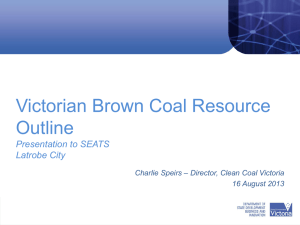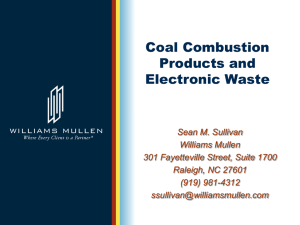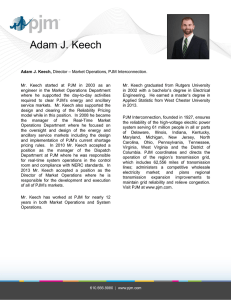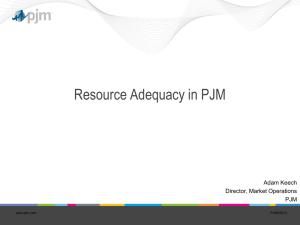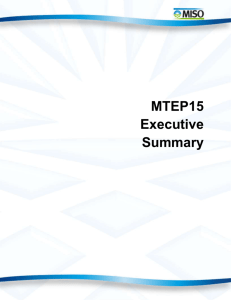E.ON PowerPoint
advertisement
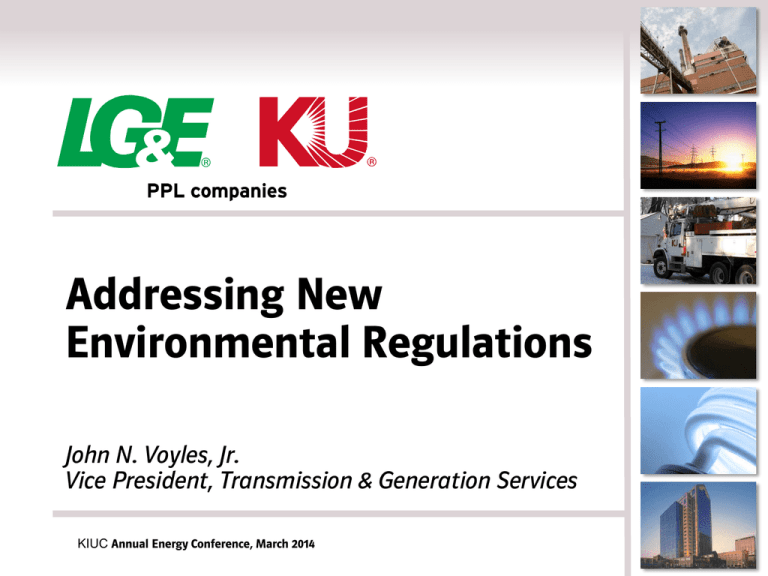
Addressing New Environmental Regulations John N. Voyles, Jr. Vice President, Transmission & Generation Services KIUC Annual Energy Conference, March 2014 Drivers from Recent EPA Regulations National Ambient Air Quality Standards (NAAQS) Cross State Air Pollution Rule (CSAPR) Mercury & Air Toxics Standards (MATS) Page 2 LG&E and KU Least-Cost Compliance Plans Install additional clean coal technology at 4 largest stations Trimble County Ghent Coal Capacity Mill Creek E.W. Brown Page 3 LG&E and KU Least-Cost Compliance Plans Additional control technology construction progressing Trimble County Ghent Coal Capacity Mill Creek E.W. Brown Page 4 LG&E and KU Least-Cost Compliance Plans Retire 800 MW at 3 coal-fired stations Coal Capacity Cane Run Green River Tyrone Page 5 Cane Run 7 Natural Gas Combined Cycle Construction Progressing Page 6 EPA Regulations Still to Come with Significant Ramifications • Coal Combustion Residuals (CCR) CO2 SF6 CH4 N2O HFCs PFCs Scope 1 Scope 2 Direct Scope 3 Indirect Indirect Employee BusinessTravel Production of Purchased Materials Purchased Electricity for Own Use Waste Disposal Company-Owned Vehicles Fuel Combustion Product Use Contractor-Owned Vehicles • Greenhouse Gas — New & Existing Source Performance Standards Outsourced Activities • National Ambient Air Quality Standards (Ozone and PM2.5) • Effluent Guidelines & 316 (b) Page 7 Coal Combustion Residual (CCR) Treatment Facilities & Dry Landfills • Dewatering systems • Beneficial reuse transfer systems • Conveying systems • • • • Transport systems Lined landfill Leachate collection Groundwater monitoring Page 8 More Carbon Regulations? • EPA has re-proposed regulations for new coal plants • EPA must propose in June 2014 regulations for existing plants • Impacts??? — Efficiency improvements? — Renewable standards? — Cost implications? Page 9 29 States and D.C. Have RPS Mandates Source: FERC Page 10 NAAQS — Revised Ozone Standard? •EPA re-evaluates standards every 5 years •2012 — The President delayed the release of the 2008 proposed ozone revision •EPA expected to issue ozone proposal this year •Ozone Transport Region (OTR) states petition to expand original participants Page 11 Effluent Limitation Guidelines (Plant Waste Water Streams) Coal Pile Runoff Cooling Tower Blowdown Metal Cleaning Wastes Misc. Water Usage Boiler Blowdown Bottom Ash Transport WFGD & WESP Blowdown Fly Ash Transport Water & Ash Pond Effluent Page 12 Meeting Future Capacity Needs in a World of Uncertainty Generation Supply is Changing Due to Retirements • Recent press clipping… — “MISO will fall below [reserve margin] targets during the 2015 summer season. If resources do not come on-line, an increased likelihood of firm load shedding is possible.” (2013 Long-term Reliability Assessment; NERC). • 37 GWs of announced retirements by 2015 in Eastern Interconnect — PJM and MISO reserve margin forecasted to decline precipitously (PJM – from 31% today to 21% in 2018; MISO – from 18% today to 12% in 2015). • Problems were widespread during January cold temps — TVA declared energy emergency alerts on 3 occasions in January 2014. — PJM experienced non-firm natural gas curtailments and 20% EFOR. — SCE&G had rolling blackouts from high load and outages. Page 14 Announced Coal Retirements Higher Than 2013 2013 2014 Plan Plan 2013 2014 Plan Plan 2013 2014 Plan Plan 2013 2014 Plan Plan 2013 2014 Plan Plan 2013 2014 Plan Plan 2013 2014 Plan Plan 2013 2014 Plan Plan 2013 2014 Plan Plan 39.0 39.3 39.4 45 Cumulative Coal Retirements Eastern Interconnect (GW) 34.9 35 30 25.8 25 20 26.0 26.5 26.8 26.8 26.8 17.0 14.7 15 10 38.7 38.3 40 8.7 9.1 11.6 7.4 5 0 2012 2013 PJM 2014 SERC 2015 MISO 2016 SPP 2017 NYiso Page 15 2018 isoNE 2019 FRCC 2020 Weather Impacts Can Result in Higher-Than-Expected Loads January 6-7, 2014 weather • Temperatures up to 30° F below normal with low of -4 °F • Winds of 10-25 mph with gusts up to 33 mph Page 16 Renewables Contribute Intermittently. . . • Limited potential for renewable generation at peak — No solar (new winter peak set after 8 p.m.) — Strong but variable winds diminished quickly — MISO wind gen. at peak hour dropped 86% from Jan. 6 to Jan. 7 Note: Wind speed does not correlate to load Page 17 System Planners Consider Key Uncertainties • Key uncertainties for potential capacity additions — Range of natural gas prices — CO2 regulations — Range of load forecast (peak and energy) • Using a probability for each scenario, a plan with the expected lowest reasonable cost is identified • Consider a range of outcomes in combination to minimize costs Page 18 A Range of Economic Forecasts are Considered… 40,000 GDP ($ Billions) High 30,000 Base Low 20,000 10,000 Base Optimistic Pessimistic Source: IHS Global Insight Page 19 $/ MMBtu Also a Range of Natural Gas Prices… 20 18 16 14 12 10 8 6 4 2 - High Med Low EIA-AEO 2013 Base EIA-AEO 2013 High Source: Energy Information Administration Page 20 EIA-AEO 2013 Low And Potential CO2 Prices 160 High 140 $/ short ton 120 Med 100 80 Low 60 40 20 - Low Mid High Source: Synapse Energy Economics Page 21 Comparative Levelized Costs of Electricity of Dispatchable Technologies — 2015 Baseload technologies Page 22 Comparative Levelized Costs of Electricity of Non-Dispatchable Technologies* — 2015 Without integration costs Page 23 Examine Alternatives Across a Range of Scenarios Alternative Natural Gas Combined Cycle Coal Simple Cycle CT Renewables Gas Med Med Med Med High High High High Low Low Low Low Load Base Base Low Low Base Base Low Low Base Base Low Low Carbon Zero Med Zero Med Zero Med Zero Med Zero Med Zero Med <-Better/Worse-> • Prefer NGCC in low-gas and carbon scenarios. Need NGCC for base load in carbon scenarios. • NGCC is not unfavorable in any scenario. • Coal response only favorable in high gas, zero carbon scenarios. • Simple Cycle CT not desirable in carbon scenarios. • High capital cost and limited dispatch flexibility reduce value of wind and solar. Page 24 Green River Station Page 25 Green River 5 — Natural Gas Combined Cycle Unit Similar to rendition of the Cane Run 7 NGCC Page 26 Photovoltaic (PV) Solar Resources PV Array in Spain 48 MW 380 acres Page 27 Potential Solar Array Location E.W. Brown Station LG&E and KU PV Array ~10 MW ~ 100 acres Page 28 Total Capital Required Trends (2009 versus 2012) 9,000 8,000 Total Capital Required ($/kW) 7,000 6,000 2009 5,000 2012 4,000 3,000 2,000 1,000 0 PC NGCC Nuclear Onshore Wind Page 29 CSP PV Levelized Cost of Electricity Trends 2009 versus 2012 500 Levelized Cost of Electricity ($/MWh) 450 400 350 300 2009 2012 250 200 150 100 50 0 PC NGCC Nuclear Onshore Wind Page 30 CSP PV Portfolio in Transition: Combined Cycle Gas Will Be 15% of Capacity by 2019 Page 31 Portfolio in Transition: 25% of Energy From Two NGCC Units by 2019 1% non-fossil Page 32 Non-Fossil Resources Increasing by 40% Since 2005 (Nameplate Capacity) MW ~ 40% * Solar capacity addition only if approved by KPSC Page 33 Non-Fossil Energy Increasing 50% Since 2005 (Intermittent Output Based on Resource) GWh ~ 50% * Solar energy addition only if approved by KPSC Page 34 2014–2018 Capital Investments No investments included for GHG regulations Page 35 Electricity Generation by Fuel, 1990-2040 (Trillion kWh by Year) Source: http://www.eia.gov/forecasts/aeo/er/pdf/0383er(2013).pdf Page 36 Regional Rate Comparison — Industrial U.S. Industrial Average per kWh is 6.60 cents 5.15¢ 6.52¢ 6.02¢ 6.30¢ 5.35¢ LG&E and KU — 5.64¢ 5.71¢ Source: Edison Electric Institute, Winter 2012, Typical Bills and Average Rates Report Page 37 6.38¢ Closing Thoughts • Current and future EPA regulations continue to impact investments and energy costs. • Supply side retirements during 2015 and 2016 will likely present transitions issues for the grid. • Key uncertainties impact near-term and long-term alternative supply resource options. • Renewable energy resources can be a part of a portfolio. • LG&E and KU continue to pursue least reasonable cost options for these challenges. of Electricity Page 38






